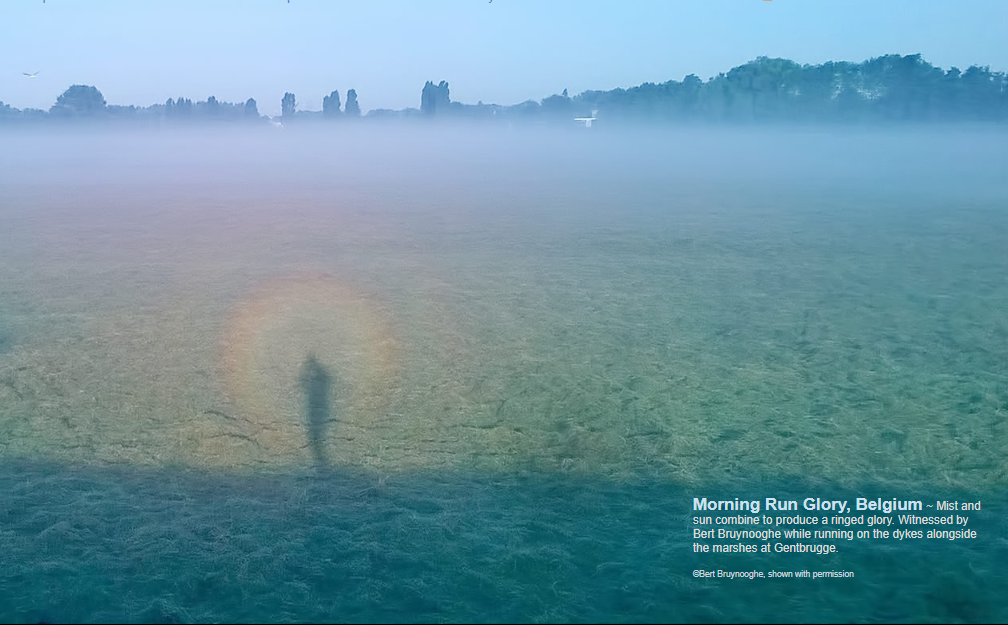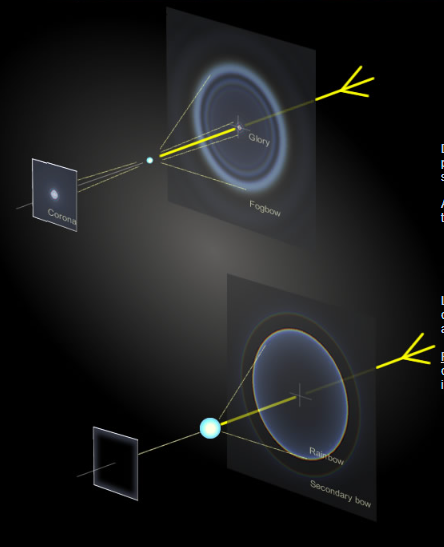Morning Run Glory, Belgium - OPOD
Morning Run Glory, Belgium - OPOD: A Captivating Atmospheric Phenomenon
The morning mist and the warm glow of the sun combine to create a mesmerizing spectacle known as a ringed glory. One such captivating moment was witnessed by Bert Bruynooghe during his morning run on the dykes alongside the marshes at Gentbrugge in Belgium. As he ventured through the misty landscape, he was treated to the ethereal beauty of a glory, leaving him in awe of nature's wonders.
A glory is an optical phenomenon that occurs when sunlight interacts with tiny water droplets suspended in the air. It appears as a series of concentric rings centered on the shadow of the observer's head. While glories can be observed under various conditions, they are most commonly seen when there is sunlight and mist or cloud present.
To witness a glory, one doesn't necessarily need to be in an airplane or on a mountain. A ship's rail over a cool sea, a milk processing factory, a dyke, or even a field can provide the perfect setting for this enchanting display. The key lies in having sunlight shining on or through enough mist directly opposite the observer. Surprisingly, just a meter or so of mist is sufficient to create a glory.
When it comes to mist, "fresh" mist with droplets of more uniform size tends to produce several rings, enhancing the visual spectacle. On the other hand, more mature mist with a wide range of droplet sizes may only result in a glow around the head or camera. So, while searching for glories, it is worth paying attention to the characteristics of the mist itself.
As Bert's image reveals, glories are not the only atmospheric phenomenon to look out for during such moments. Shadows cast by the low sun can create intriguing effects, particularly near the antisolar point. The antisolar point is the spot in the sky directly opposite the sun. It is the home of glows, the glory, heiligenschein, and the opposition effect. Shadows tend to hide behind objects, but near the antisolar point, they align in a way that conceals them from view.
The size of the water droplets plays a crucial role in the formation of glories. Droplets with a diameter ranging from 5 to 50 microns diffract sunlight, creating the captivating rings that define a glory. Interestingly, a fogbow and corona are part of the same outcome as a glory. However, when it comes to larger drops, such as raindrops, diffraction is less pronounced, resulting in a small and unnoticeable glory. Instead, refraction dominates, giving rise to a sharp rainbow.
In summary, the morning run glory witnessed by Bert Bruynooghe in Belgium showcases the mesmerizing beauty of a ringed glory. This atmospheric phenomenon occurs when sunlight interacts with tiny water droplets in mist or cloud, producing concentric rings centered on the observer's shadow. Whether it be on a ship's rail, a mountain, or simply a field, witnessing a glory is a reminder of the awe-inspiring wonders that nature has to offer. So, next time you find yourself surrounded by mist and sunlight, keep your eyes peeled for this enchanting display of light and beauty.

Morning Run Glory, Belgium ~ Mist and sun combine to produce a ringed glory. Witnessed by Bert Bruynooghe while running on the dykes alongside the marshes at Gentbrugge.
©Bert Bruynooghe, shown with permission

Search for a glory whenever there is sunlight and mist (or cloud). An airplane is good. Or a mountain. But a ship's rail over a cool sea, a milk processing factory, a dyke or sometimes a field will suffice. The key is the sunlight shining on or through enough mist directly opposite. As seen above, only a metre or so of mist is enough.
“Fresh” mist is best for its droplets have a more uniform size and generate several rings. More mature mist with a wide range of drop sizes might at most give a glow around the head or camera.
While glory searching look too for shadow hiding, the opposition effect. Bert’s image show shadows from the low sun except near the antisolar point. There they hide behind the shadow casters.
The antisolar point is the home of glows, the glory, heiligenschein and opposition effect.
Droplets 5-50 micron diameter produce glories. They diffract sunlight.
A fogbow and corona are part of the same outcome.
Larger drops, like raindrops, still diffract light but their glory is small and unnoticeable.
Refraction rather than diffraction dominate. No glory or corona but instead a a sharp rainbow.
Note: this article has been automatically converted from the old site and may not appear as intended. You can find the original article here.
Reference Atmospheric Optics
If you use any of the definitions, information, or data presented on Atmospheric Optics, please copy the link or reference below to properly credit us as the reference source. Thank you!
-
<a href="https://atoptics.co.uk/blog/morning-run-glory-belgium-opod/">Morning Run Glory, Belgium - OPOD</a>
-
"Morning Run Glory, Belgium - OPOD". Atmospheric Optics. Accessed on November 26, 2024. https://atoptics.co.uk/blog/morning-run-glory-belgium-opod/.
-
"Morning Run Glory, Belgium - OPOD". Atmospheric Optics, https://atoptics.co.uk/blog/morning-run-glory-belgium-opod/. Accessed 26 November, 2024
-
Morning Run Glory, Belgium - OPOD. Atmospheric Optics. Retrieved from https://atoptics.co.uk/blog/morning-run-glory-belgium-opod/.